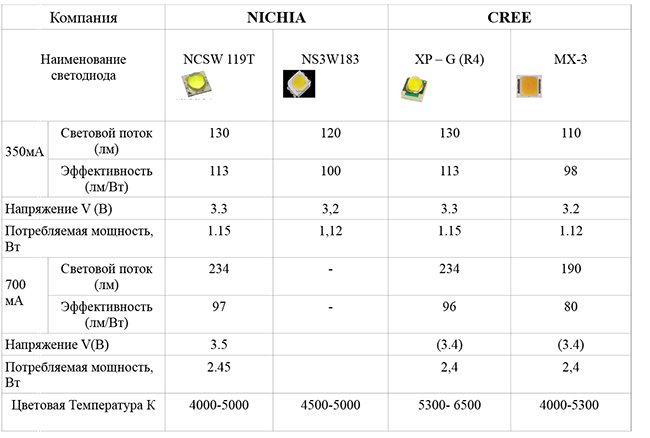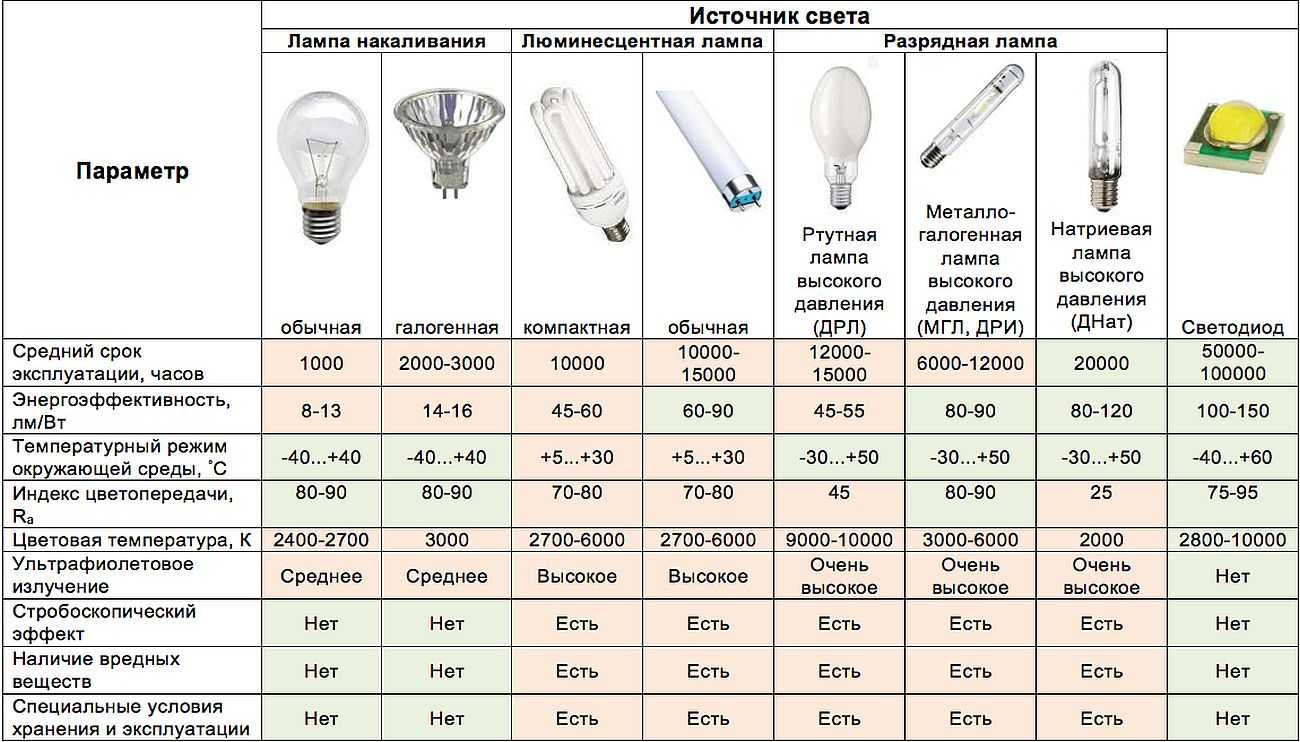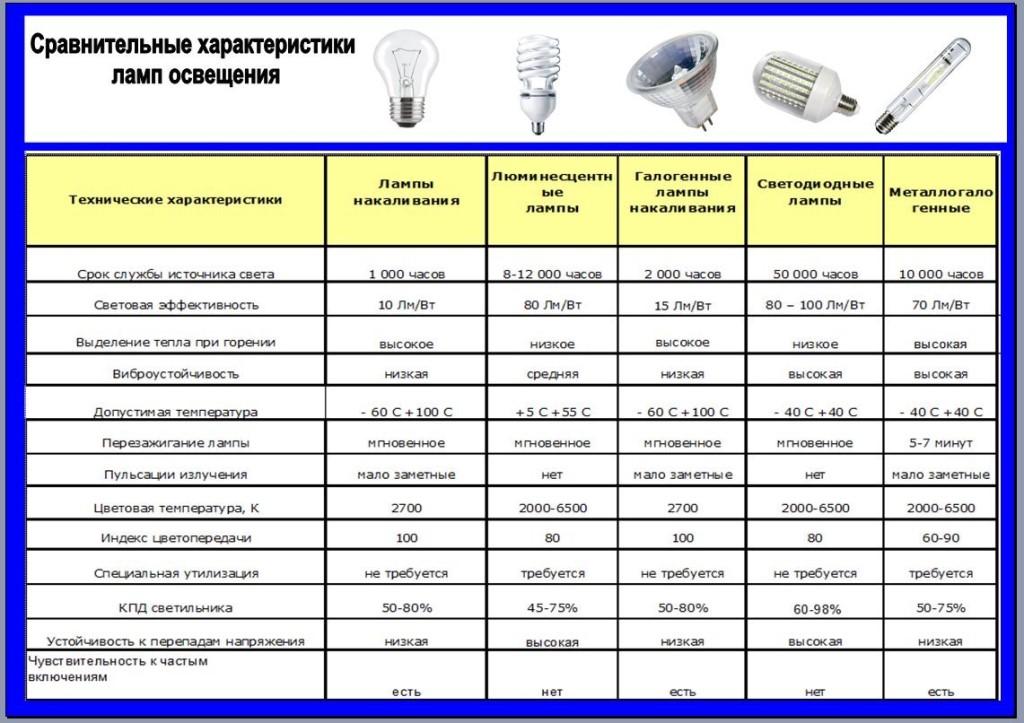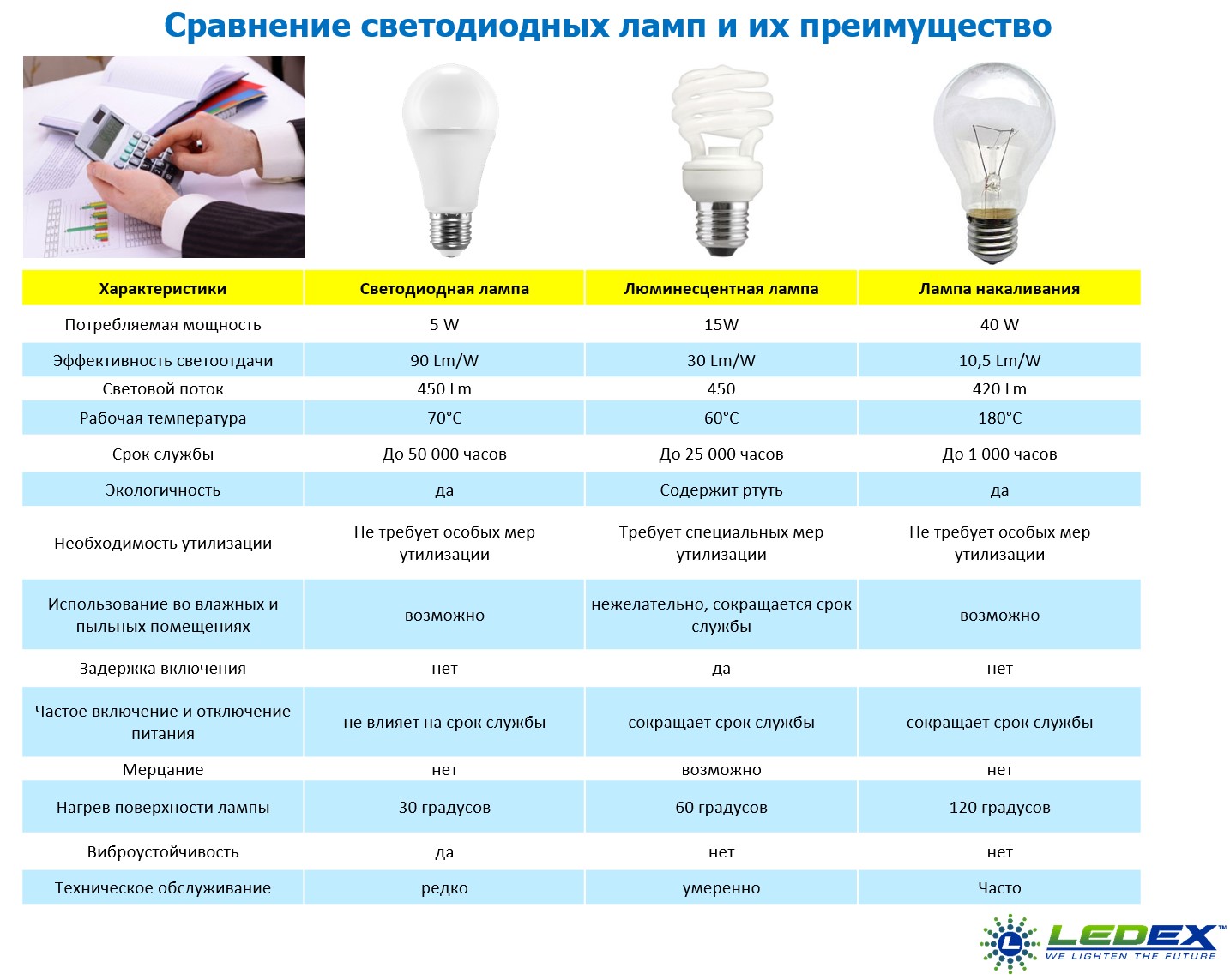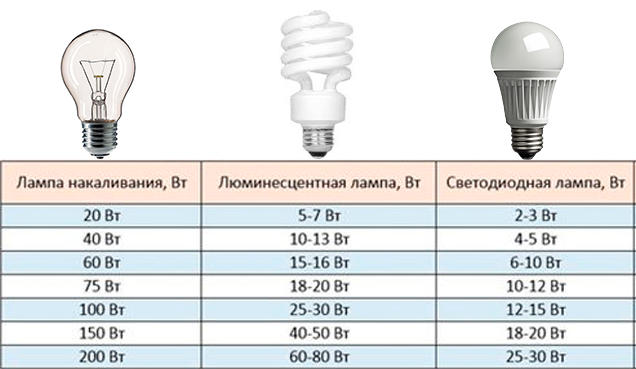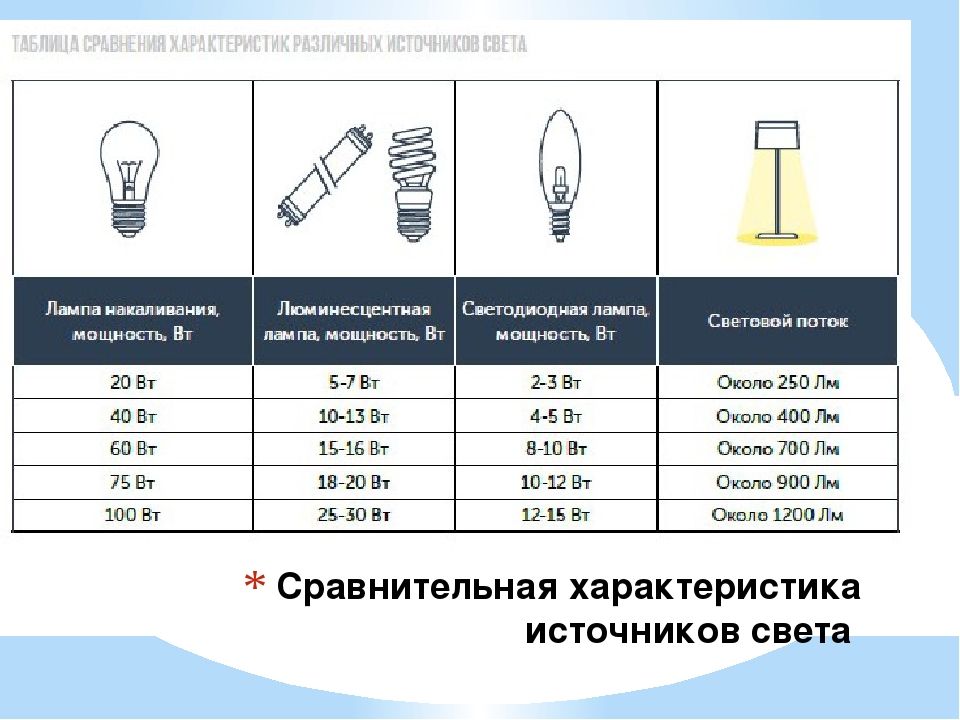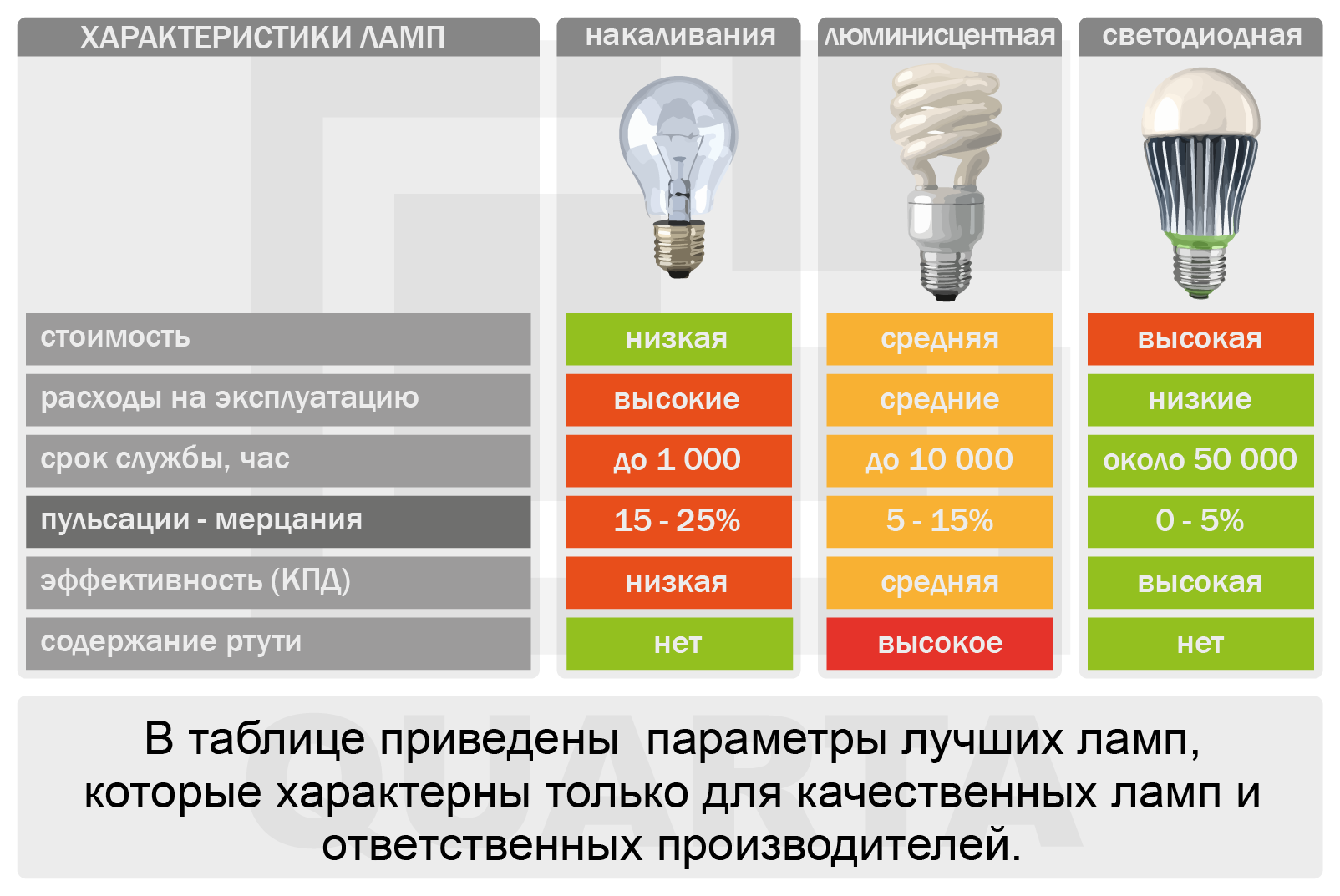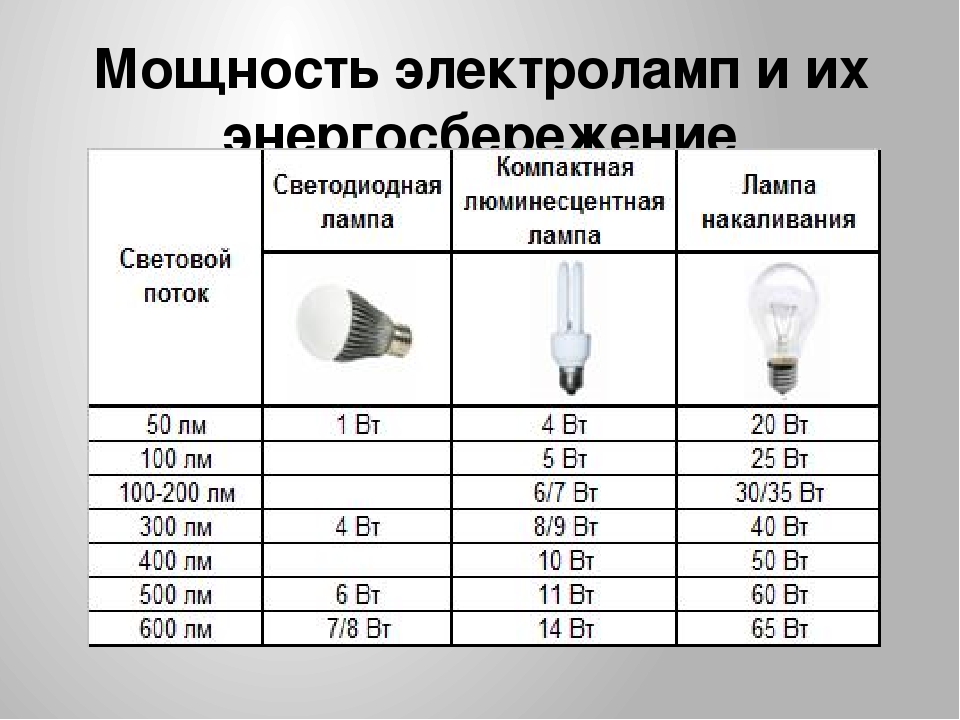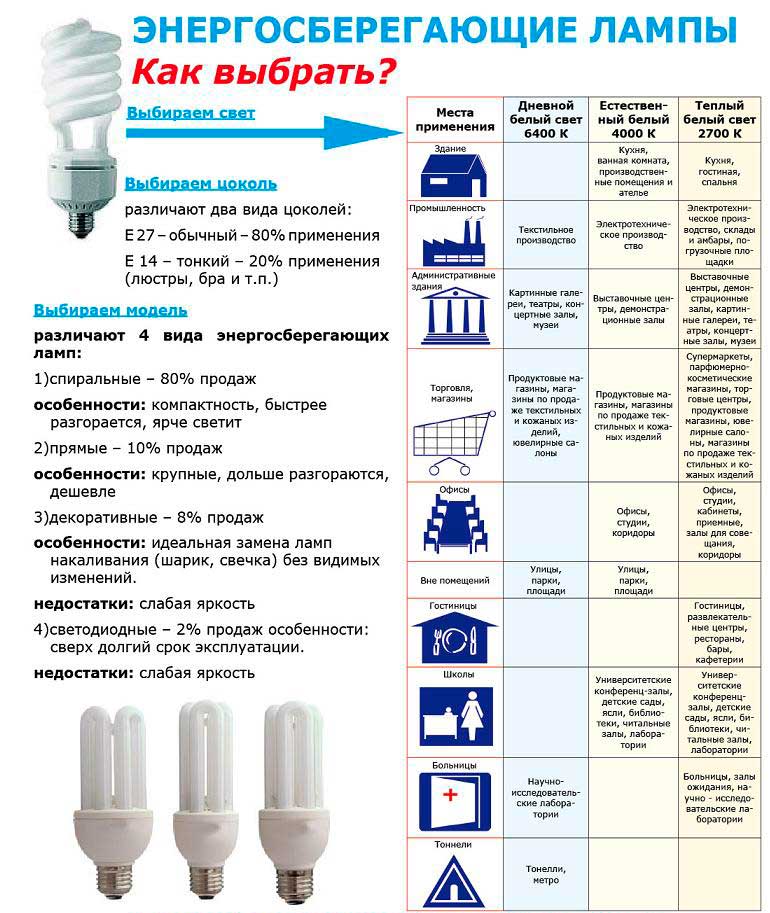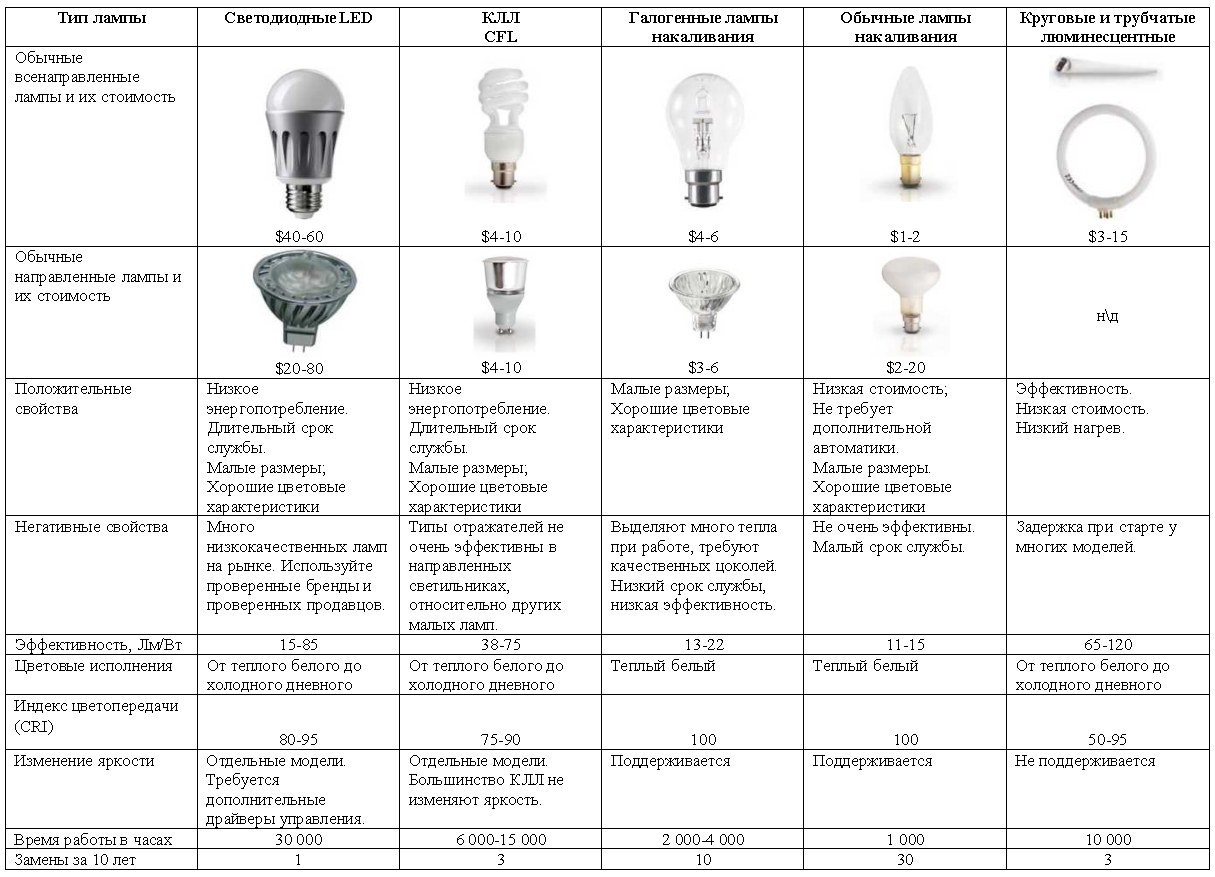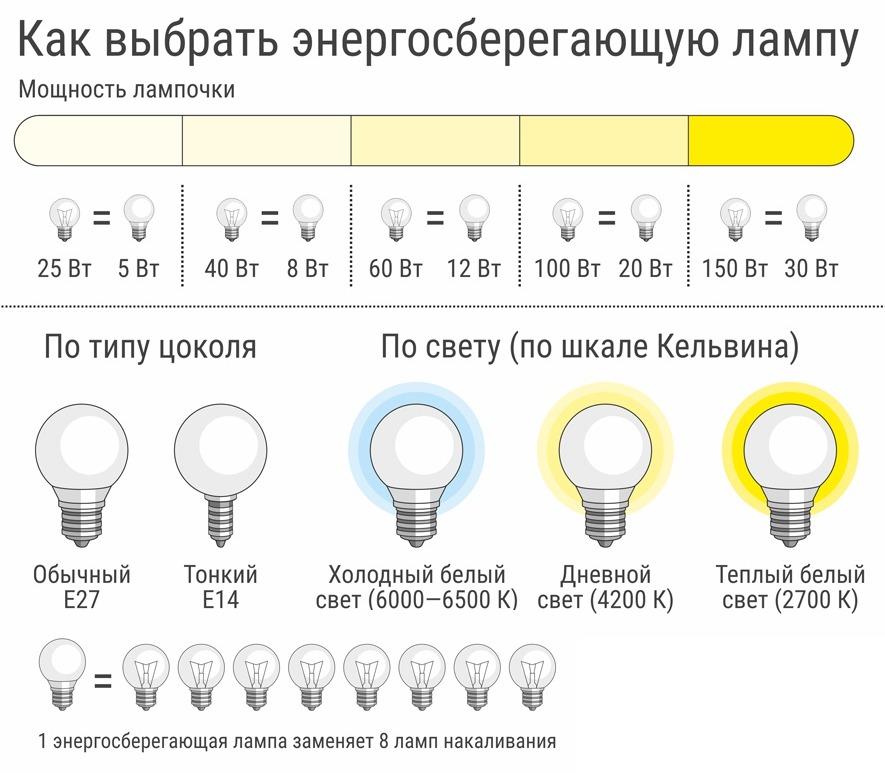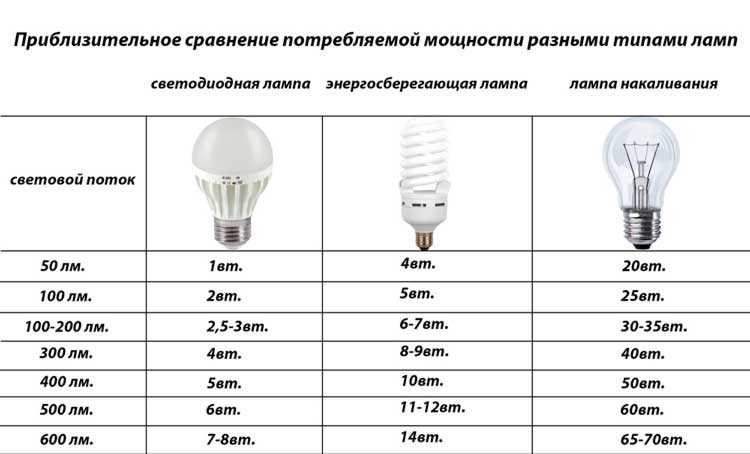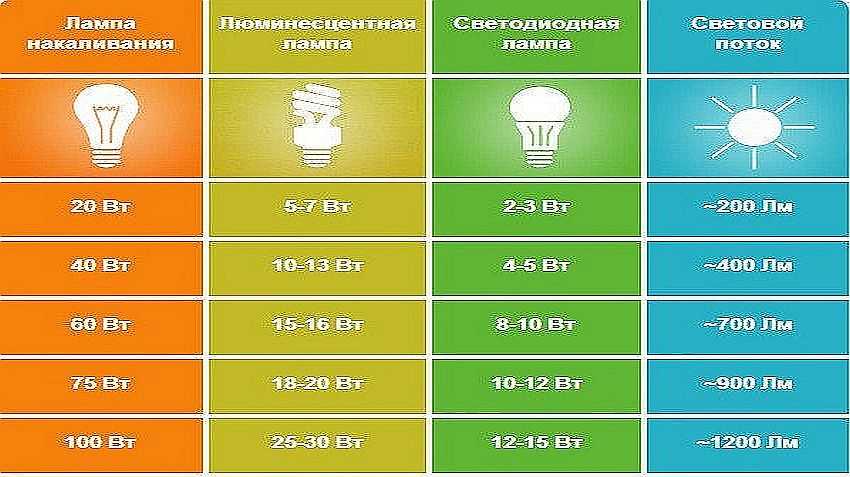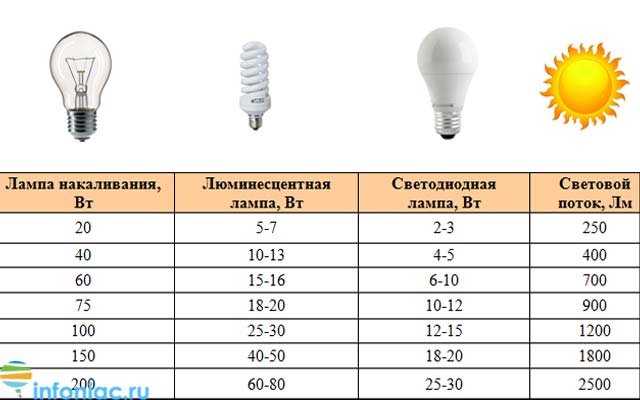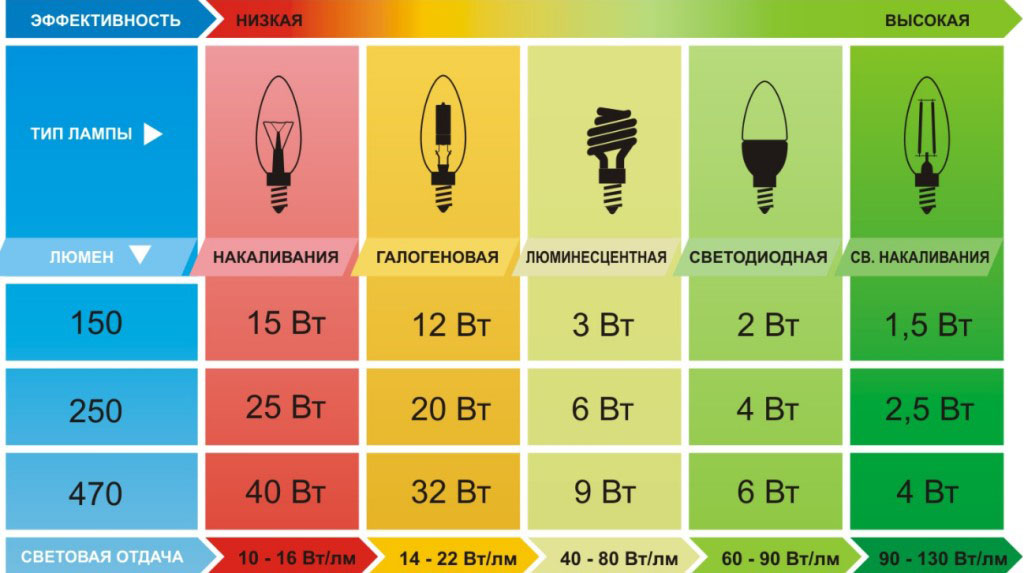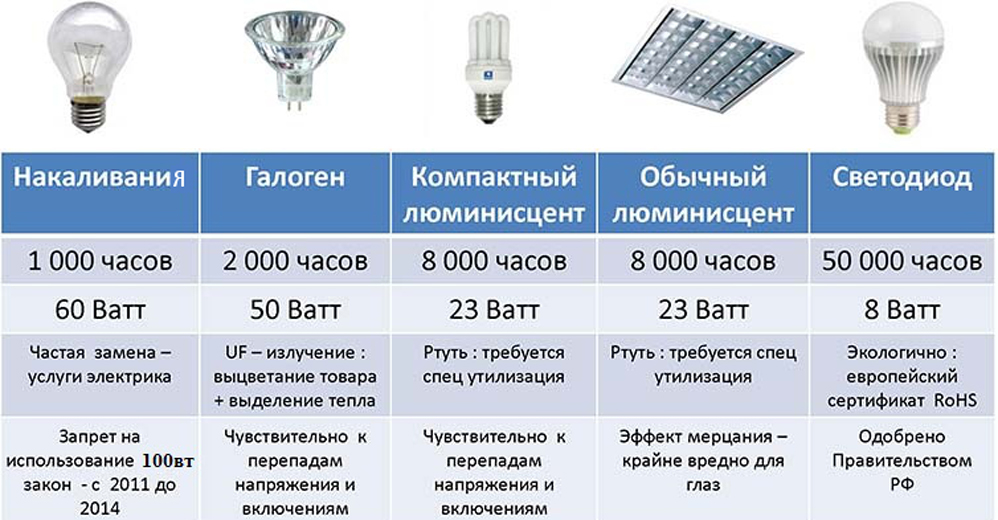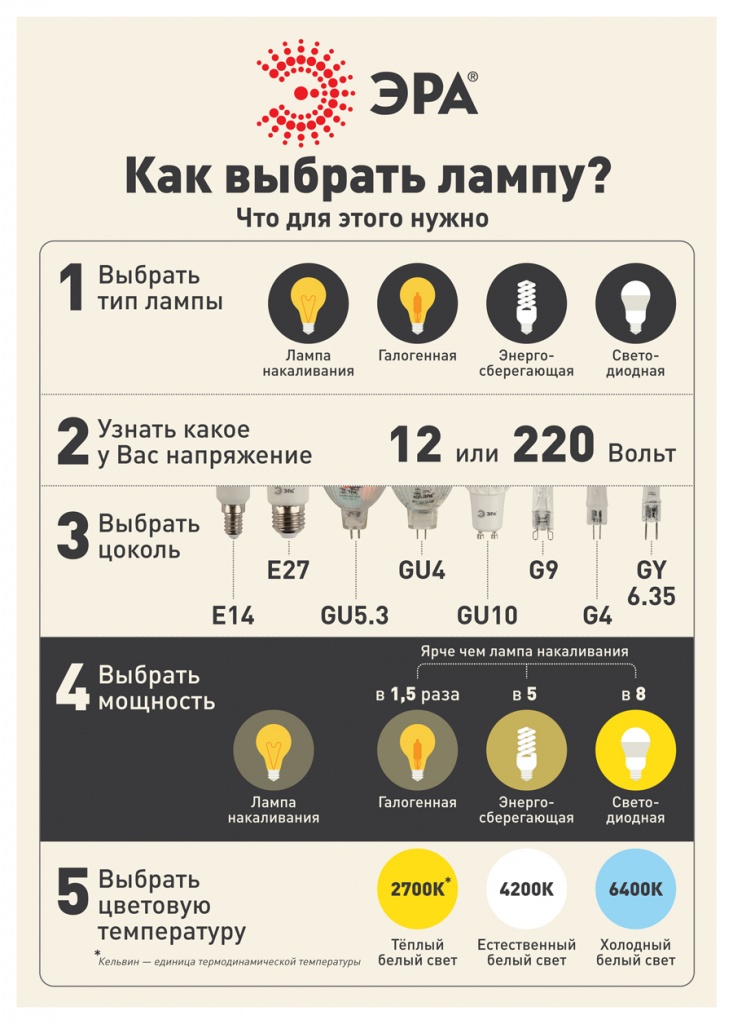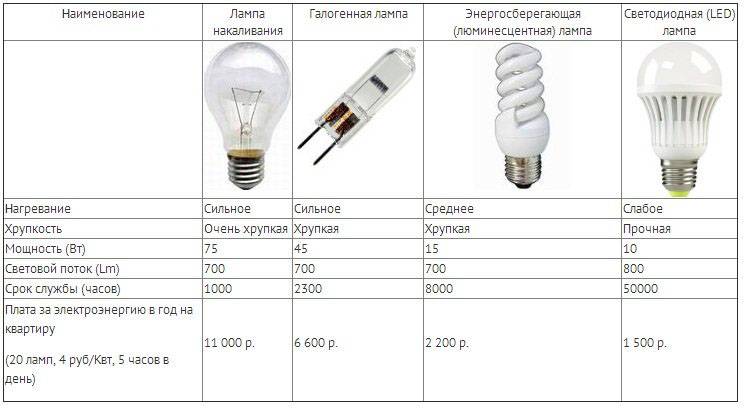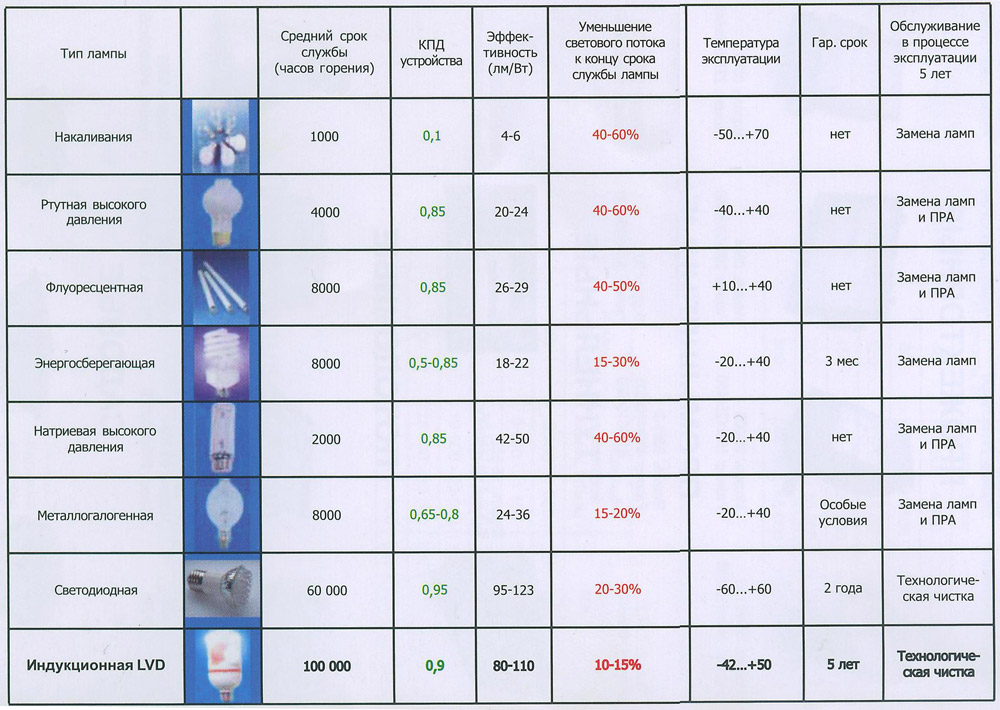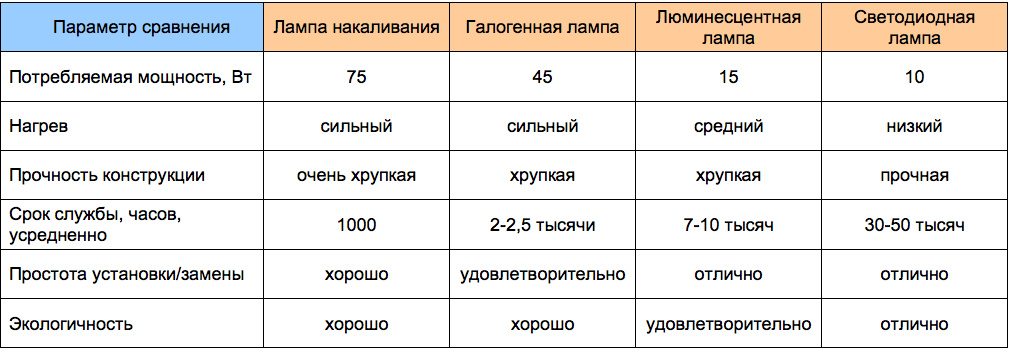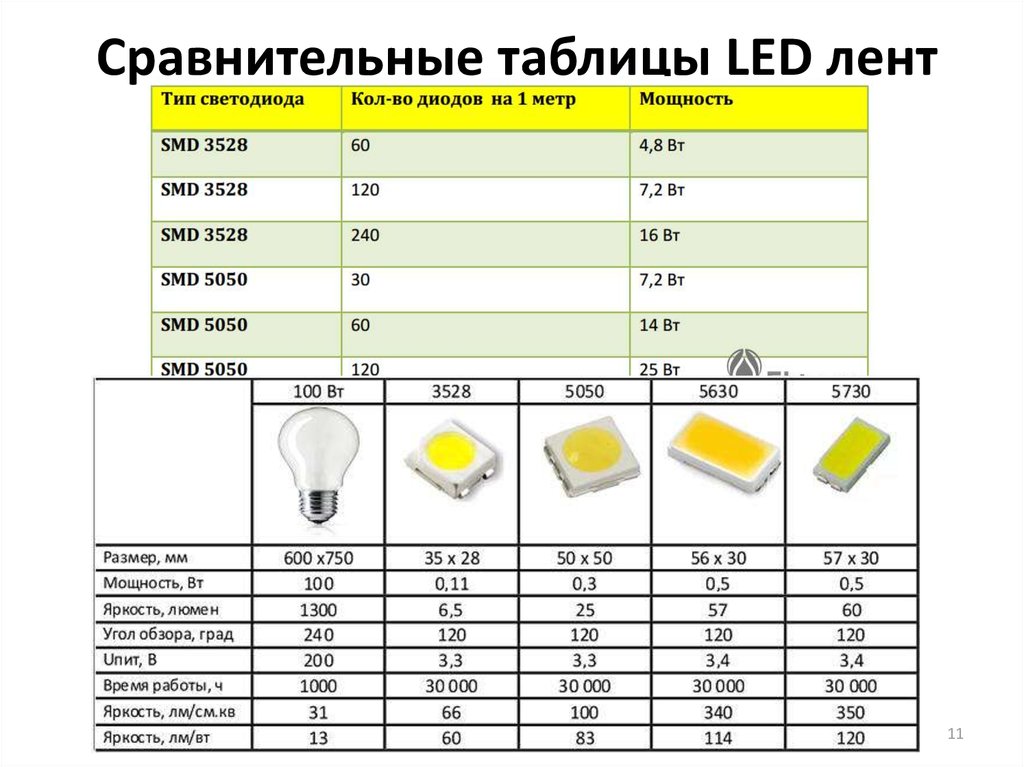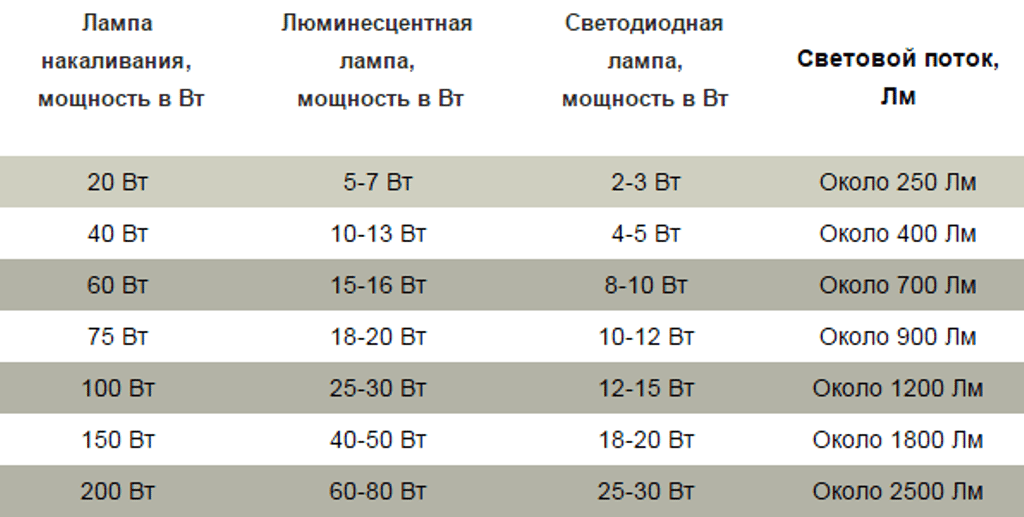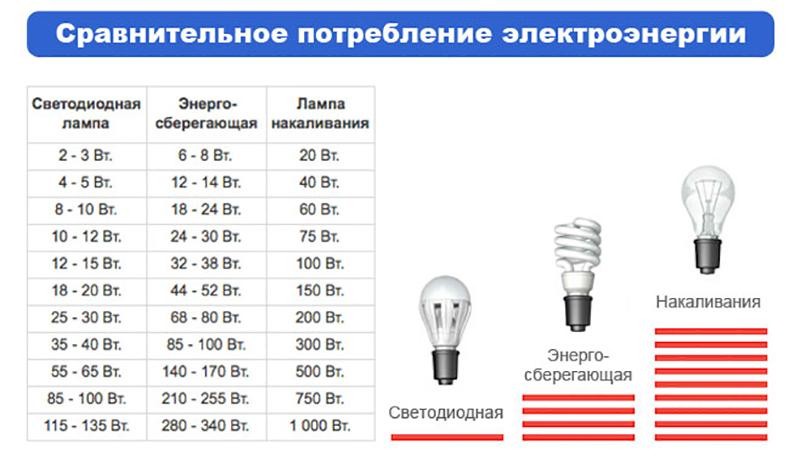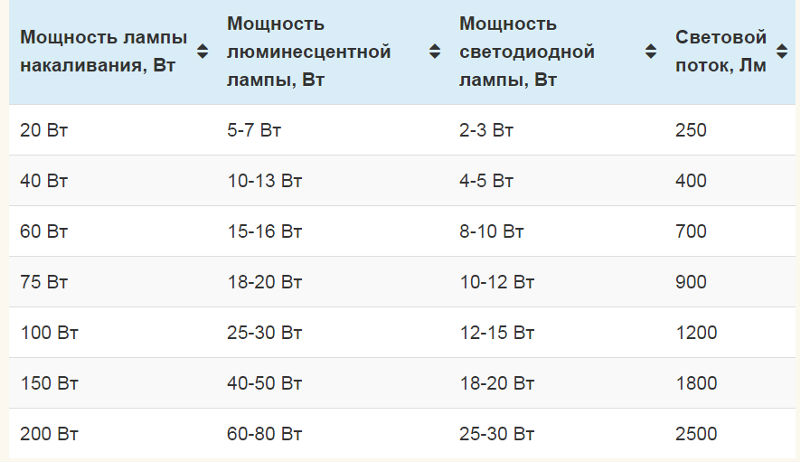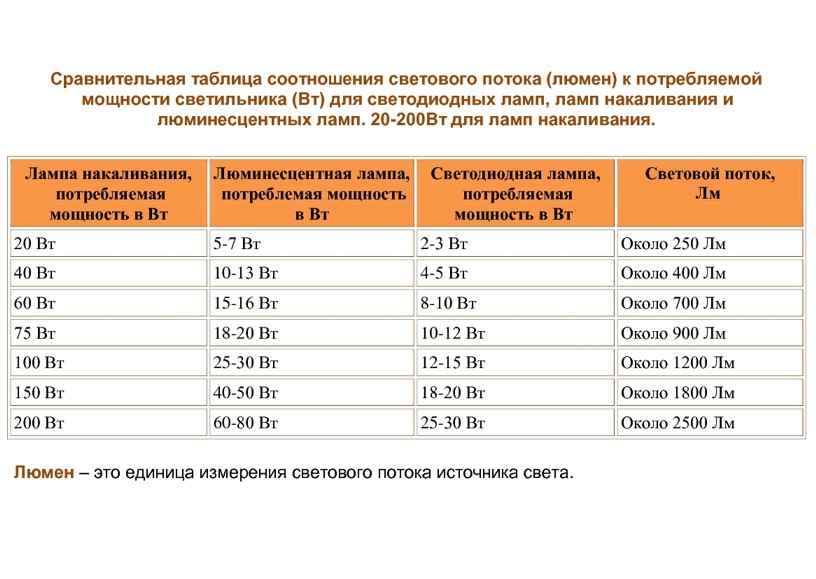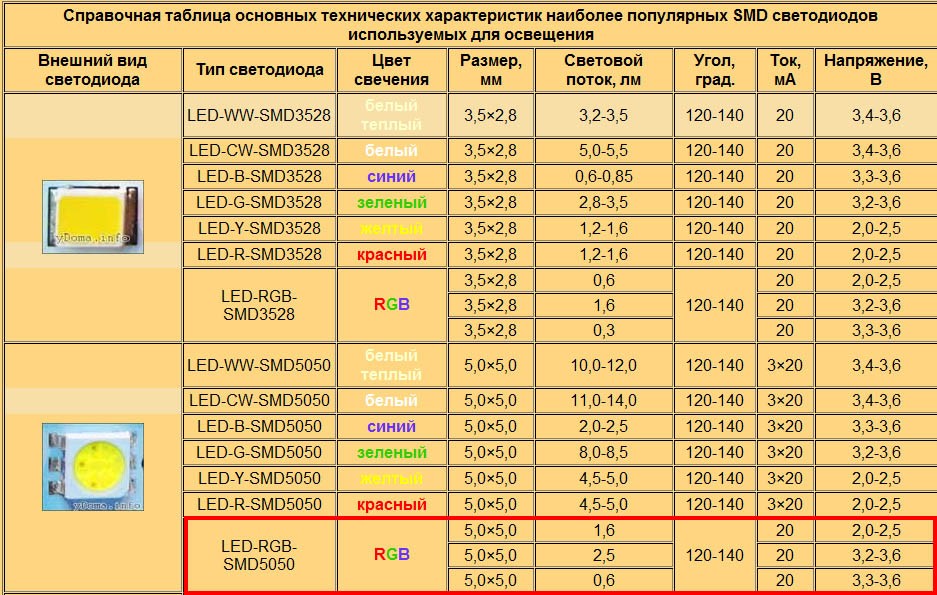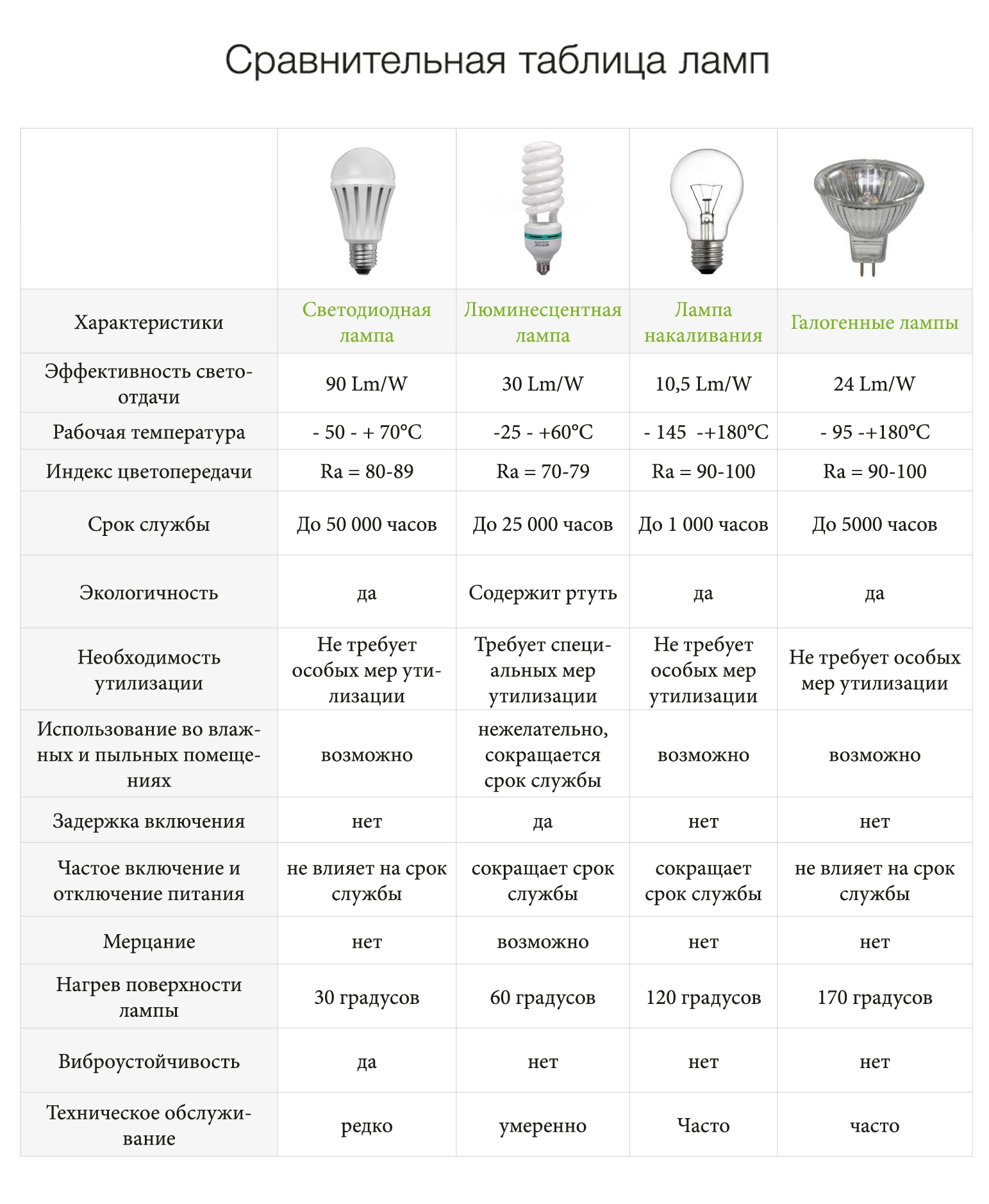Lamp efficiency
The coefficient of performance (COP) is closely related to all previous parameters of lighting lamps. Each device has a "useful action" - this is the job for which, in fact, the device was created. In lamps, the main beneficial effect is the emission of light. Everything else is unnecessary and unnecessary work and reduces efficiency. Incandescent lamps have a very low efficiency, because the main part of their work is associated not with a beneficial effect, but with a side effect - radiation of heat. This value (efficiency) for such lamps barely reaches 5%. This means that only 5% of the electrical energy consumed is spent on emitting light. And this is a very low figure. He talks about the inefficiency and inefficiency of the device.
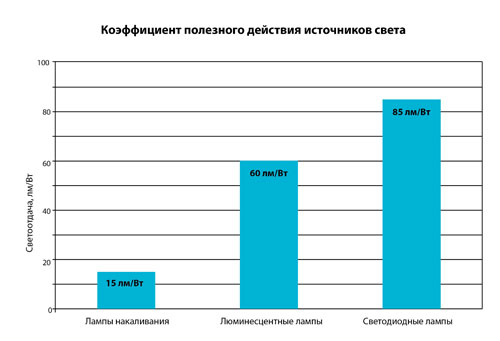
LED lamps have a high efficiency of about 90%. That is, LED devices do not waste energy on useless work and save electrical energy, and, therefore, save the user's budget.
Illumination standards
There are lighting standards for each room.
Bedroom, kitchen
Any apartment has a bedroom and a kitchen, which should be well lit. If these rooms are too large, 2-3 lamps will have to be installed. They will provide illumination at the level of 150-200 Lx.
Children's room
People with a child have a children's room in the apartment. Most often, such rooms are smaller than bedrooms, and therefore they do not need to be illuminated with bright lamps.
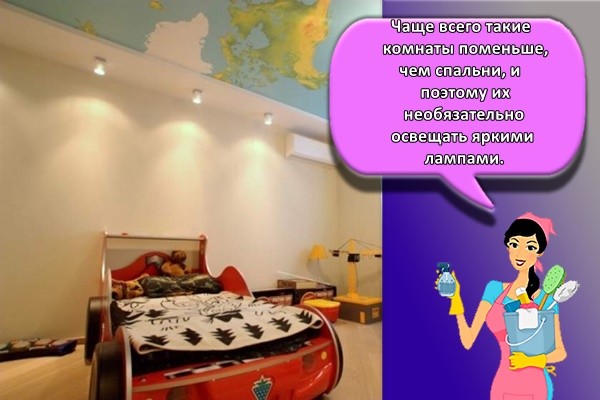
Bathroom, toilet
A toilet with a bathroom is the smallest room in the apartment. Even weak LED bulbs are suitable for lighting them, which will provide an illumination of 45-50 Lx.
General office
The office space is very large and is therefore equipped with powerful lighting fixtures. The optimal illumination for the office is 250 Lx.
Drawing office
The brightest light is needed for drawing offices. Their illumination level must be at least 400 Lx.
Lamp design
The main elements of an LED lamp that affect the quality of work are: LEDs, a cooling radiator and a driver (built-in power supply).
For a long service life, the radiator must be of high quality. The radiator is located between the bulb and the base and serves to cool the driver. The correct heatsink is a ribbed aluminum structure with longitudinal slots allowing free air convection inside the lamp. In some low-cost options, manufacturers allow poor placement of ribs and slots. This will not provide good heat dissipation and the lamp will quickly fail. Also, production is often made cheaper and the radiator is made of plastic. Such a product can only be used for short-term work, because plastic does not provide sufficient cooling to the lamp, unlike aluminum, which has a high thermal conductivity. Although they are already introducing good composite materials.
Since the radiator is located inside the device, it is impossible to assess its quality at least visually, therefore, when choosing an LED lamp, you should focus on cost. The higher the cost, the more chances it has the right radiator.
The driver (transformer, power supply) is almost the main component of the lamp. Its function is to transform the input voltage of 220V into the one needed for the 12V lamp. A cheap driver doesn't always do this well. For example, some Chinese options give unstable performance at the output.
Also, a low-quality power supply is unlikely to withstand the voltage surges that often occur in homes.
Manufacturer
All the criteria described above directly depend on the manufacturer, therefore, when choosing an LED lamp, you should not give in to the desire to save money and buy an inexpensive analogue, but stop at a fairly well-known company that does not use low-quality parts in the production.
According to a survey conducted among buyers, a whole list of manufacturers of LED-type lamps has been compiled, producing really high-quality products that do not cause complaints in the process of use.
The best manufacturers of LED type lamps are:
- Svetlana-Optoelectronics;
- Optogan;
- Philips;
- "Nichia";
- "CREE";
- "Osram";
Base and shape
After determining the main technical characteristics of an LED lighting device, you should familiarize yourself with other, equally important qualities. Any lamp is installed in a special socket. The dimensions of these mounting elements must match each other.
 Types of plinths
Types of plinths
An important parameter is the form of the structure. The direction of the luminous flux and the area of illumination depend on it. Of course, when installing a lamp in a lighting device, you need to take into account its characteristics - the location of a reflector or other device for concentrating light radiation. This parameter for the LED design should be no less than that of the device itself. Otherwise, the lighting efficiency will be artificially lowered.
Depending on the shape, the lamps are divided into classic, point, bar and volumetric. The choice depends on the degree of light scattering.
| Manufacturer | Power, W | Cost, rub |
| CRIXLED classic | 10 | 190 |
| BIOLEDEX E27 400 vol. | 5 | 1140 |
| With T8 base | 10 | 945 |
As can be seen from the data in the table, the cost of LED lamps is many times higher than with an incandescent spiral. But if you calculate the subsequent savings, then the choice will be obvious
It is only important to comply with the operating conditions. LEDs are negative for overheating
Therefore, it is recommended to purchase models with aluminum radiators.
A quality lamp should have a radiator
It is a protective device that is designed to remove high temperatures from the LED unit. It should be in the form of an aluminum ribbed surface. Unscrupulous manufacturers replace this metal with plastic to reduce the cost of their products. This is unacceptable for a quality product. Since the plastic outlet is not able to cope with the functions assigned to it. On this occasion, a lot of negative reviews from people who had the opportunity to test lighting devices with a plastic radiator
Therefore, those who are thinking about how to choose the right LED lamp should pay attention to this design detail. The cooling radiator is extremely important for the normal and long life of the lamp.
If the manufacturer has saved on material or the protective device has poor contact with the LED, the lamp will not use up its resource and will fail after six months of use.
Then how to choose a frosted LED bulb? In this case, it is not possible to look at the presence of a radiator and the material from which it is made. Therefore, if possible, it is better to refuse to purchase such a lighting device.
Correspondence table of power and luminous flux
When changing bulbs, it is necessary to take into account the correspondence of the power of incandescent and LED lamps, as well as the strength of the luminous flux. The characteristics are measured in the same quantities. To navigate the indicators and correctly translate the values, you can be guided by the following table of ratios.
| Ilyich's light bulb (W) | LEDs (W) | flux (lm) - approximate value |
| 20 | 2-3 | 250 |
| 40 | 4-5 | 400 |
| 60 | 8-10 | 700 |
| 75 | 10-12 | 900 |
| 100 | 12-15 | 1200 |
| 150 | 18-20 | 1800 |
| 200 | 25-30 | 2500 |
Based on these indicators, you can pick up a replacement bulb.For example, a 60W incandescent lamp corresponds to a 7W LED lamp - in order for the conversion to be correct, they are guided by the data on the package. On the other hand, it is necessary to take into account the general characteristics and operating conditions.
The values presented indicate one of the main advantages of LEDs - economic benefits.
How to choose the right price and manufacturer
When choosing a new lamp, you need to pay attention to the manufacturer and the cost of the product.
Expensive or cheap
Some people are trying to save money and buy cheap models because of this. However, it is better to overpay a little and buy more expensive lamps, since they are of much better quality.
To select and purchase a quality lamp, you need to get acquainted with well-known manufacturers.

Philips
This company is a leader in the production of lighting fixtures. Philips products are known for their durability and reliability.
Osram
People looking to buy quality lamps should take a look at Osram. Products from this German brand are almost in no way inferior to the bulbs made by Philips.
Wolta
This is another German manufacturer specializing in LED light bulbs. The advantages of products from Wolta include an even distribution of light.
Nichia
Japanese company engaged in the production and sale of LED light bulbs. The company is also known for its quality batteries.
X-Flash
Fans of economical light bulbs can pay attention to products from X-Flash. The company produces energy-saving twelve-volt luminaires for residential lighting
Lisma
Lisma is considered a popular LED lighting company among all CIS countries. Products manufactured by this company are distinguished by a wide illumination angle.
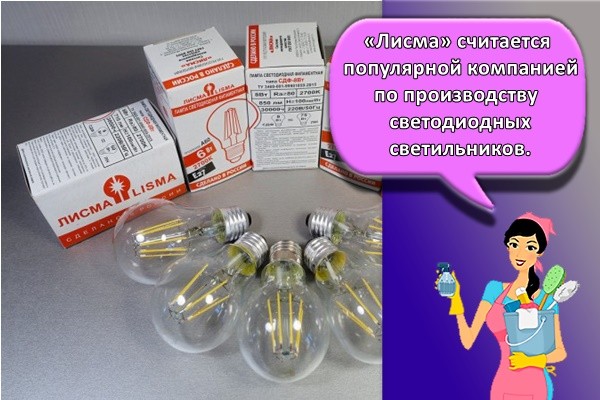
Navigator
The company produces energy saving light bulbs of various shapes and types. Navigator also produces decorative items used for interior decoration.
Gauss
This manufacturer is known for its quality lighting technology. Products that have been manufactured by Gauss have a lifespan of seven years.
Camelion
High quality products are manufactured by the "Camelion" company. The range of manufactured products includes lamps for the home and products for street lighting.
Feron
A wide range of products is manufactured by the Feron company. They are engaged in the production of light bulbs that glow red, green, daylight and white.
Jazzway
The company is engaged in the creation of high-power lighting fixtures that are suitable for large rooms or streets.
Era
Era is a young company that has recently started to create electric lamps. The variety of products allows a person to choose the right product.
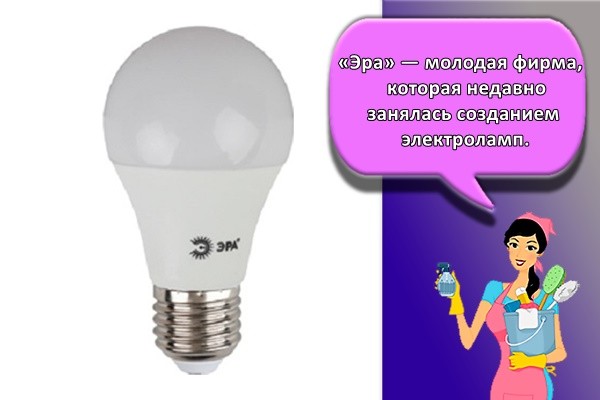
Selecta
Another young company that appeared several years ago. "Selecta" produces electric lamps, spotlights, electric cartridges and even sockets.
ASD
People on a budget can purchase fixtures from ASD. They are considered the best in the budget segment.
"Space"
This is a Russian company that has been producing LED lamps for 25 years. Cosmos manufactures quality lamps that are suitable for home use.
LED lamp shape
The range of produced LED lamps is diverse. There are two types of lamps - "corn" (with open LEDs) and closed. "Kukuruzy" are practically out of production due to insufficient fire safety.
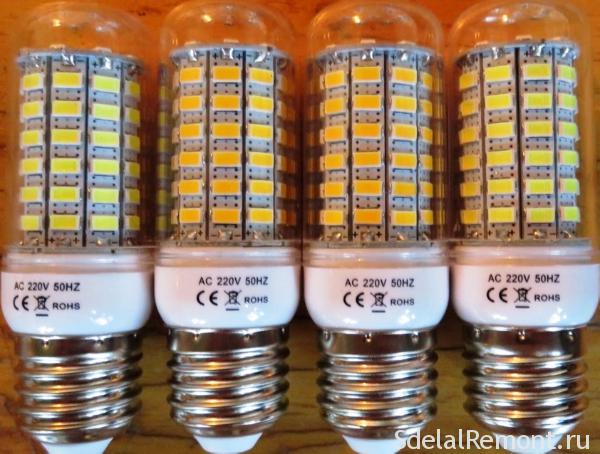 LED corn lamp
LED corn lamp
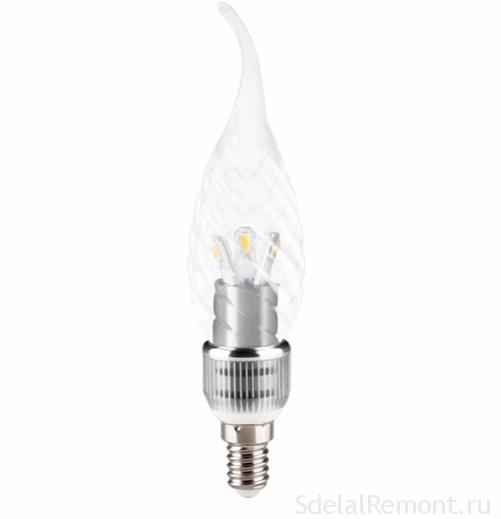
The shape of the bulb of the closed lamp repeats the shape of the usual, familiar to everyone, the "Ilyich" light bulb. These are a "pear", a classic ball and a candle, a "candle in the wind" with a curved tip, with a mirror bulb, etc. There are transparent and opaque. Frosted lamps diffuse light better and look more aesthetically pleasing. LEDs are not visible. It is better to put them in open lamps. Light bulbs with a transparent bulb are placed in closed lamps."Candle" and "candle in the wind" look beautiful in hanging open lamps and sconces. Mirror LED bulbs are used instead of halogen analogs and incandescent lamps in spotlights of directional light.
Important properties and characteristics of LED lamps
Finding good LED bulbs for your home can save you money. One of the main advantages of such lighting is that it does not have hazardous components. An important point is the value of energy consumption, which is 10 times less than that of standard products.
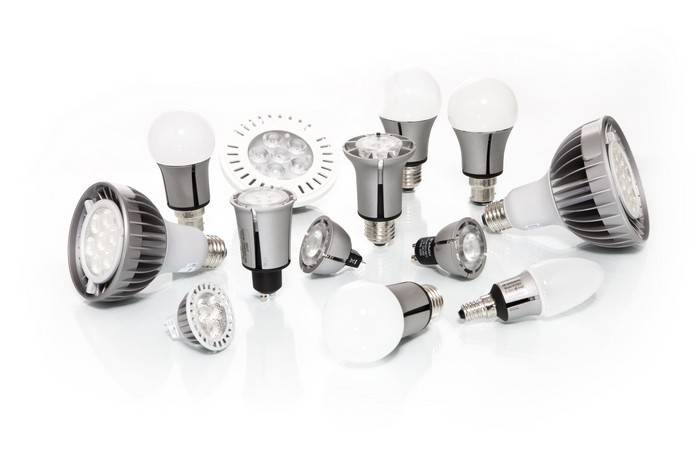
LED light source options
Such lighting devices have the following characteristics:
- increased luminous efficacy;
- low energy consumption;
- long service life;
- have a uniform glow that does not tire the eyes;
- are safe in use;
- resistance to voltage drops;
- versatility of the device.

Properly selected lighting allows for stylish interiors
These qualities unite all LED devices, but there are differences between the products that relate to the base / plinth option, the dimensions of the case and the power of the equipment.
Characteristics selection rules
There are several parameters that must be taken into account when choosing lighting devices.
Base types
Experts recommend paying attention to the features of the bulb base
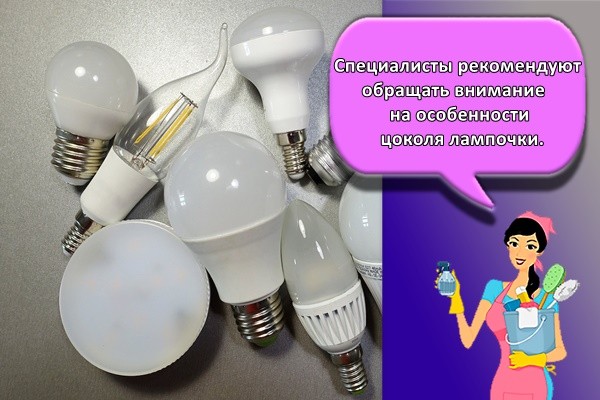
E5
Such a plinth is used in compact devices that are installed in small rooms. The diameter of the plinth case does not exceed five millimeters.
E14
Small plinth, often used in the manufacture of lamps for residential lighting. The diameter of the hole for screwing in the bulbs is fourteen millimeters.
E17
A model with small dimensions, used to illuminate medium-sized rooms in apartments or private houses. The diameter of E17 is seventeen millimeters.
E26
Medium-sized construction into which lamps with a power of up to 100 watts are screwed. The base hole diameter is twenty-six millimeters.
E27
This base is practically no different from the E26 model. The only minor difference is that its diameter is one millimeter larger.
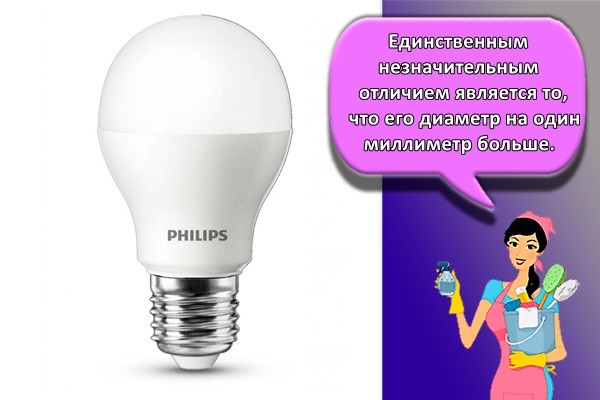
E40
Large base used for screwing in LED bulbs. Most often, such a large structure is used when organizing lighting on the street.
Glow color
Lighting elements may differ in glow color.
Warm white light
To create a cozy atmosphere in the room, experts recommend buying light bulbs that illuminate it with warm white light. The color temperature of such lamps reaches 2800 Kelvin.
Natural white light
So that the colors in the apartment do not distort and look normal, lamps with natural light are installed. They are suitable for children's rooms, hallways and kitchen work areas.
Cold white light
There are two types of white light that you should be familiar with.
Natural
Cold light is rarely used in living spaces. However, luminaires that illuminate the space with natural light will work well for most rooms in an apartment.
Day
Daylighting is advised to be used in office spaces as it contributes to the creation of a working atmosphere. Neutral light shades improve concentration and increase productivity.
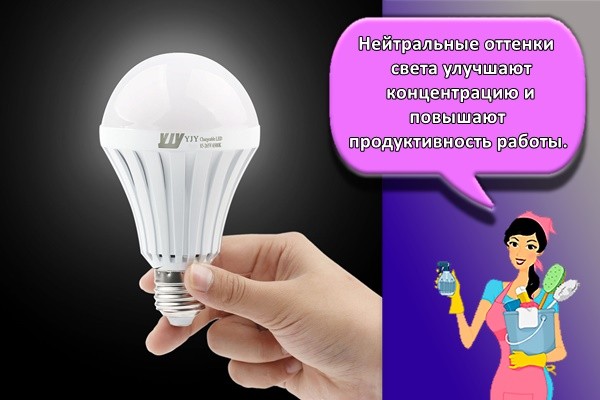
Selection recommendations
In order to choose the right color for the glow, it is necessary to take into account the peculiarities of the room in which the luminaire will be installed. For living rooms, models with warmer shades are suitable, and for work offices it is better to buy lamps with cold light.
Supply voltage
Lighting devices may differ in supply voltage.
G9
LED lamp powered by 220V voltage. The power of this light bulb is four watts.Most often, such models are used to illuminate interior elements or a suspended ceiling.
R39, R50, R63, R80
These are high-quality lighting devices that are able to provide uniform illumination at voltages from 150 to 250 V. They are used to illuminate residential and industrial premises.
G4
Economical light bulbs, which are considered the best analogue of halogen lamps. Such devices are compact, versatile and economical in electricity consumption.
MR16
These are compact luminaires used to illuminate residential premises. The operating voltage is 12-15 Volts, however there are models that can only work at 220V.
GX 53
A versatile luminaire used to decorate illuminated advertisements, illuminate a shop window or organize interior lighting. Emits cool white light during operation.
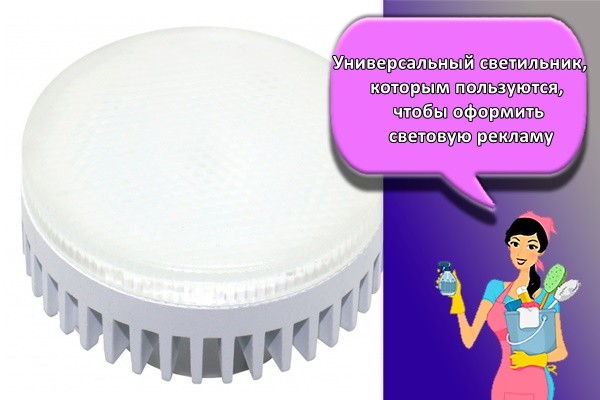
When choosing a luminaire, pay attention to the power of its work. The quality of room lighting depends on this parameter.
It is recommended to buy 20-30 W bulbs.
Design and operation features
LEDs of various power are used as the main light source in the structure. They are located on the mounting platform, which is connected to the control elements of the device. The latter are necessary for converting the parameters of the current and ensure the operation of the lamp.
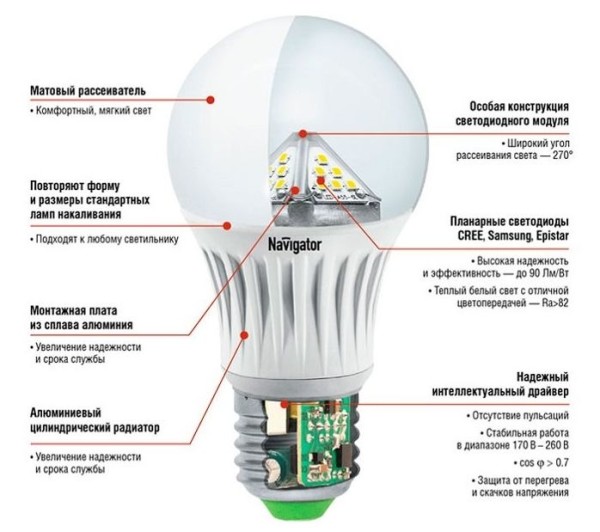 Lighting device design
Lighting device design
This design is the reason for the following positive qualities of the operation of LED illuminators.
- Long service life. It can reach 50 thousand hours of work.
- Reduced energy consumption. When compared with a 100 W incandescent lamp, an LED similar in luminous flux will consume only 22 W. Read about other ways to save energy.
- Resistant to voltage drops, but only if it does not go beyond the normal range. It will not change the light intensity or color.
But for the consumer it is important to know the basic qualities of the lighting device, which will further affect its service life and quality of work.
Why are the LED lights off?
In some cases, LEDs have their own problems, for example, an off LED lamp is on. What if this problem occurs? There are a number of reasons why the LED light is on when the switch is off:
· This may be due to faulty wiring in certain locations. Therefore, this problem needs to be urgently eliminated;
· The off LED lamp blinks if the connected switch is backlit;
· If the design uses low-quality emitters.
Is it dangerous that the turned off LED lamp glows? There is no danger for wiring, but the life of the lamp itself, this drawback will shorten. Therefore, it is necessary to think through all these points and eliminate malfunctions, if they exist.
LED bulbs for home

Today, there is an acute issue of saving on utilities, and, as you know, most of all we spend money on electricity. And that is why the question of saving is acute and, oddly enough, one of these ways is to buy an LED lamp.
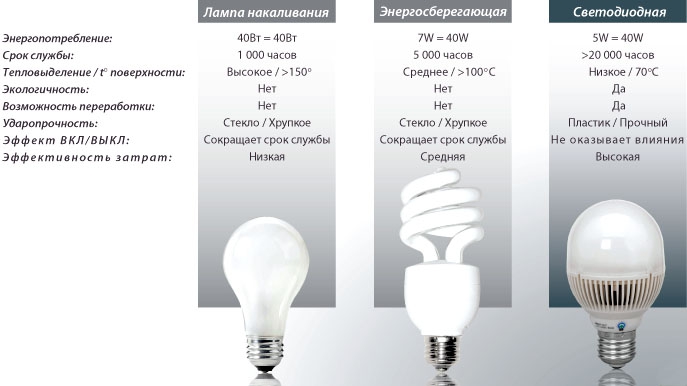
Advantages of LED lamps:
- As already written earlier, such lamps are absolutely harmless, since they do not contain chemical additives, which means that they are absolutely harmless and will last a long time - this is one of the most important advantages of such lamps.
- The second no less significant advantage is low power consumption. Basically, it is ten times less than that of similar lamps.

Description of LED lamps and how they work
When buying any product, we ask ourselves questions: how safe is it, and what are the guarantees of the quality of this product?
The quality of the LED lamp is its unique design, which includes three basic and reliable elements of work, and the lamp life depends on their quality.

The lamp design includes:
- The main LED is the light source. I would like to note right away that it is best to buy lamps with several LEDs, so you will be sure that the light bulb will serve you for quite a long time;
- Small transformer. It is required for accurate and safe voltage redistribution. I would like to note that this is the most delicate detail in the entire design of the LED lamp, and separately it is sold at a far from democratic price. If the transformer is of inadequate quality, then such a lamp will last a maximum of a week and it will be wasted money;
- Radiator for cooling the lamp. It must constantly cool the LED and heat sink to avoid overheating the lamp. This element in the design is more auxiliary and must necessarily have a good ventilation system (as for its small size).
Pros and cons of LED lamp
 The topic of this article would not be fully disclosed if we did not talk about the pros and cons of LED lamps.
The topic of this article would not be fully disclosed if we did not talk about the pros and cons of LED lamps.
Advantages:
It is important to know: of course, this is a conditional indicator, because the operating time depends on how often and carefully you will use it. It should also be remembered that today you can accidentally acquire a defective sample, which, unfortunately, can only work for a few months.
- A feature of lamps with built-in LEDs is their resistance to the external environment, which means that they can be safely used to illuminate the courtyard of your house even in the fiercest winter.
- It is environmentally safe to dispose of such lamps (since they do not contain harmful toxins);
- These lamps do not emit ultraviolet light. This means that they can be used in special rooms (for example, in an art gallery, where paint in paintings can fade from ordinary light bulbs).
Disadvantages:
Of course, these lamps have few disadvantages. These include:
- Price. It is slightly higher than that of an ordinary light bulb (but, not critical);
- LED lamps cannot be installed in closed luminaires (since the light can be dimmed);
Where can you use LED lamp
 Thanks to the very bright LEDs, these lamps can be used almost anywhere. For example, by densely placing them on the ceiling, you can get a sufficiently bright lighting that can be adjusted in a wide range of light.
Thanks to the very bright LEDs, these lamps can be used almost anywhere. For example, by densely placing them on the ceiling, you can get a sufficiently bright lighting that can be adjusted in a wide range of light.
Also, the LED can be used not only as the main, but also auxiliary lighting (illumination inside the cabinet or drawer). In general, you can use an LED lamp almost anywhere (the use case depends solely on your imagination).
GOST. Lamp power.
In 2004, the GOST 8607-82 standard was adopted. "Luminaires for lighting residential and public premises."
Its meaning is to limit the power of each type of lamp to a certain value. Those. our manufacturers cannot produce bedside lamps that consume more than 25 watts. As well as the limitation for each lamp in this luminaire. Everything is tied to the standard type of electrical network in apartments and houses. Moreover, our rules, as it turns out, are even less strict than abroad. Thanks to this, the luminaires of foreign manufacturers are quite suitable for our power grid.
So, limiting the power of the lamp:
- 550 W - for general lighting fixtures (the power of one lamp is not more than 150 W);
- 180 W - for combined lighting fixtures (the power of one lamp is not more than 150 W);
- 150 W - for exposure (spot) lamps (power of one lamp not more than 100 W) and decorative lighting (power of one lamp not more than 60 W);
- 25 W - for bedside lamps (orientation lighting) (the power of one lamp is not more than 25 W).
What are
First you need to familiarize yourself with the types of lighting fixtures.
Standard
More often than not, people buy standard types of light bulbs. They are distinguished by their classic pear-shaped shape. The light output of such models is 70 lm / W.
RGB lamps
People who want to decorate an apartment in a non-standard way can purchase RGB models. Their main difference from other types of LED bulbs is that they can glow in any color.
Rechargeable
These are mobile devices that are used to illuminate a small area. They do not need to be plugged in as they are battery operated.
LED lamps with remote control
Ice devices are considered convenient for home use. They are controlled by a remote control that sends a signal to the lamp using infrared radiation. The advantages include:
- build quality;
- profitability;
- the presence of a remote control.
How to understand what power of an LED lamp to choose
In recent years, many have been leaning towards the smart decision to switch to LED bulbs. It is not only convenient but also economical. Compared to incandescent lamps, they have solid advantages. One of the most important benefits is cost savings. Try replacing all the lamps in your apartment with LEDs - and you will pay much less for electricity. At the same time, the quality of lighting will improve markedly, because the light from these bulbs does not blink, they do not burn with voltage drops and are completely safe for health. The only problem is how to choose?
How often have you had to stand in the lighting department, vainly trying to find the right LED? Sometimes in such cases sellers-consultants approach buyers, who categorically point to the most expensive model and say: "Take this, you won't regret it, I use it myself." A familiar situation, isn't it? This usually only adds to the confusion and does not help in any way. In fact, the choice can be much easier, it is enough just to understand the ratio between the power in incandescent lamps or "housekeepers" (if this option is closer to you) and in LED.
That is, as we can see. LED lamps with lower power give a powerful stream of light. It is due to this that it is possible to achieve savings in their use.
The easiest way is to select a lamp not by power, but by the number of lumens. This gives a more complete picture of what kind of stream of light comes from her. For example, a 5 Watt "X-Energy" LED lamp has 550 lumens, which is average between 40 Watt and 60 Watt incandescent lamps. This is quite enough for household use. This light bulb will find its use in the kitchen, bathroom, bedroom, living room or hallway. Among the range of lamps of this power, you can choose models with a warm or cold glow. Since this is the most popular option. these lamps are produced, as a rule, with an E27 base.
An equally common option is a 9 Watt LED lamp. Its luminous flux is 850 lm, which is equivalent to a 75W incandescent lamp. It is designed for more demanding consumers who like well-lit rooms. Such lamps are suitable for a study, office space, library. They give an even stable bright light, easy to read or do delicate work. They are harmless to the eyes and resistant to voltage surges. This makes the use of these bulbs not only comfortable, but also durable. While conventional and even energy-saving lamps have already served their purpose, LED lamps will still work, delighting you with their high-quality light. Therefore, their cost is fully justified and reasonable.
The next time you go to the light bulbs department, you won't be so easily confused. Remember to navigate. first of all, by the number of Lumens, it is by them that you can determine the power of the glow.Therefore, if you like bright light, feel free to take the maximum, especially since you will not have to pay dearly for such a pleasure. Energy-saving technology for the production of LED lamps allows you to provide a stable and high-quality glow that does not consume a lot of electricity. Such a light bulb is a worthy investment, especially in light of recent events related to currency fluctuations. Therefore, feel free to take it today, because tomorrow it can cost several times more!
You can ask additional questions by phone: +38 097 795-09-08
We will definitely answer all your questions as soon as possible.


